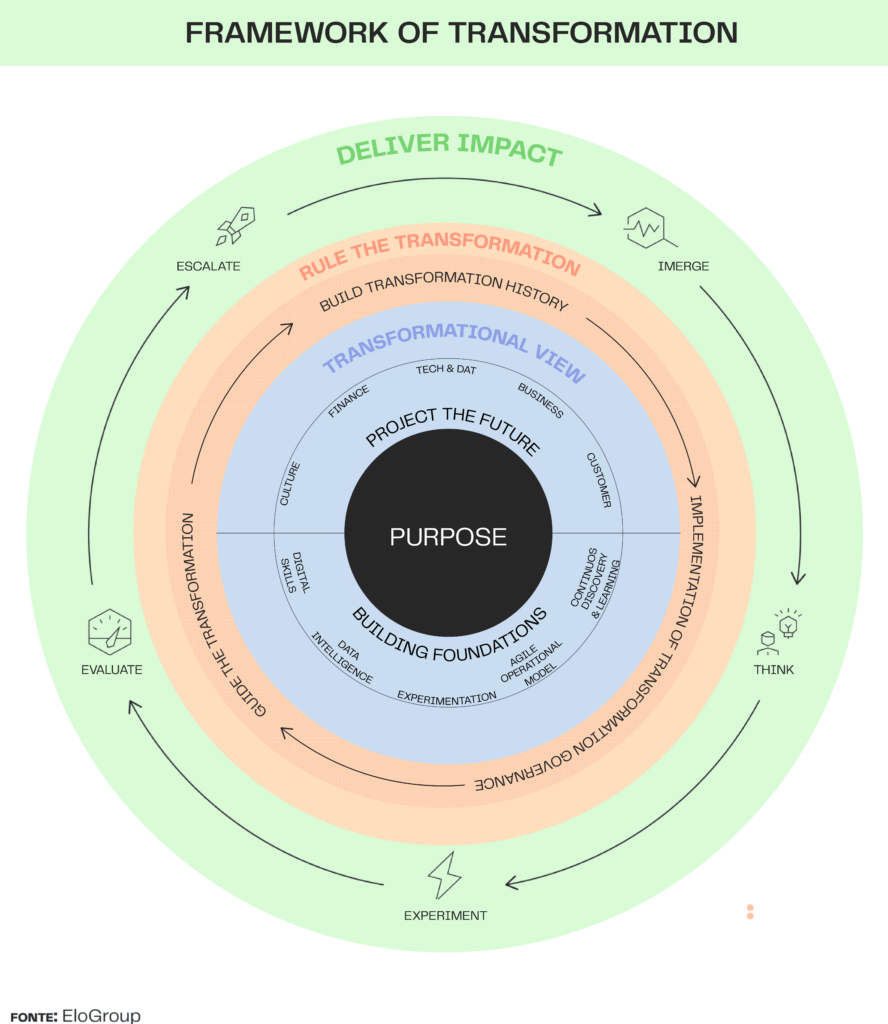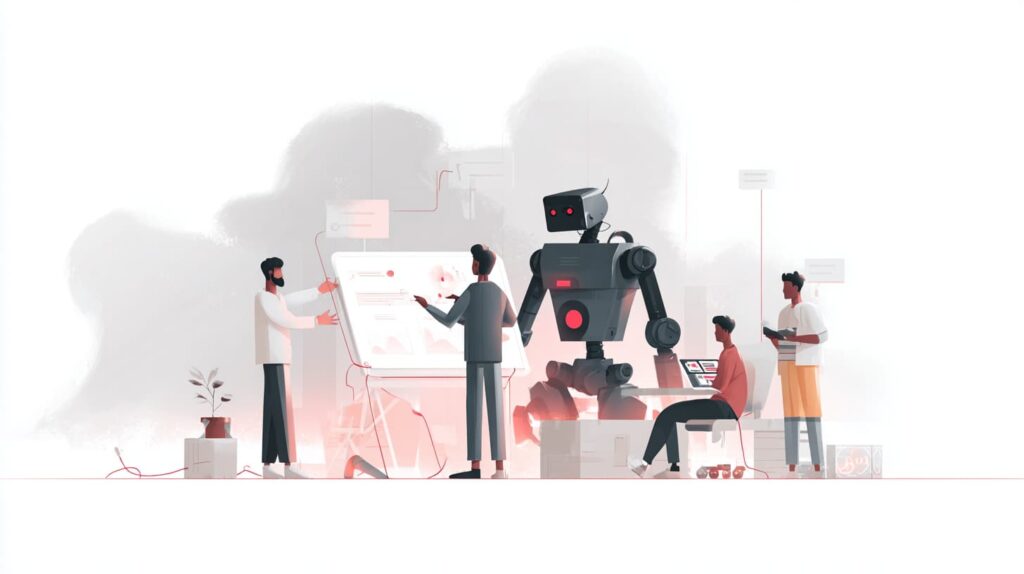By EloInsights, in collaboration with Marcos Navarini
- Transformation requires governance to set up support mechanisms, check and recognize results.
- When conducting the process, special attention must be paid to engaging and motivating the people involved in adopting a new status quo.
- Let’s analyze some of the mistakes that can pulverize the potential of change and how change management concepts can help to overcome them.
This is the second article in a series of four on the Great Battles of Transformation that will be published on EloInsights.
In “Transformation Battles: how to project the future”, the first article in this series, we saw how the formation of a transformative vision, capable of guiding important organizational changes, begins with projecting the future, aligned with a purpose and a macro strategy – with key goals to be achieved. Following our framework, we will now focus on the governance phases, which include building the transformation narrative, leading the process itself and implementing support and monitoring mechanisms.
We will turn to the concepts of change management, which aim to minimize the impact of the transformation on stakeholders by reducing barriers, accelerating the assimilation of new competences and the consolidation of a new status quo, always in a process of cyclical renewal.
In the challenge of preparing for change and throughout the organization’s journey in this direction, the greatest risk is that of pulverizing the transformation’s potential. That is why it is important to emphasize a few key words: engagement, empowerment, recognition and abandoning the earlier context.
Leaders who are close to other employees engage and motivate to overcome the natural resistance to change, while, at the same time, training people and defining performance metrics for monitoring and consolidating the new processes. Change management eases all these tasks through four main stages, according to the framework used by EloGroup, derived from Kurt Lewin’s model: Plan, Unfreeze, Change and Refreeze. Each of these stages is briefly described below.
- Planning: it is the preparation, always guided by purpose and mapping out which processes and people will be affected. Metrics are also defined to monitor results;
- Unfreeze: consists of analyzing and reviewing the organization’s current standards that need to be changed. It directly involves the people in the organization – who need to feel included and motivated to assimilate the benefits of the transformation;
- Change: corresponds to the process itself, which involves learning and training, and includes follow-up by stakeholders and a transition evaluation process; and
- Refreeze: the last stage is to solidify the new status quo and guarantee the closure of the implementation by celebrating results, recognizing those involved and formulating strategies so that there is no regression to the previous context.
Although the method described solves a large part of the issues, we will now look at some common mistakes that can appear during this second big “battle”, the stage of governance and conducting the transformation:

Mistake 1: Creating an unconvincing narrative about the govern transformation
Communicating the purpose that will guide the changes in a convincing and motivating way is one of the focal points for mobilizing a coalition, winning over allies to make the entire process a reality.
This is what the transformation narrative refers to. It also relates to ensuring stakeholder buy-in – that is, the active participation in the adoption of new models and dynamics. Failures occur by not considering each of the organization’s target audiences. Some techniques and paths can mitigate these problems:
- Mapping stakeholders and employing storytelling techniques guide actions to shape communication. Framing different profiles, assessing attitudes – of promoters, neutrals or detractors, for example – is a way of personalizing and communicating the transformation according to the target audience, conveying the message through more empathetic and human stories. Efficient and convincing communication favors the process of employee identification and adherence to change, as it helps to relate the goals of the transformation to the individual and collective aims of the groups affected.
- Defining success criteria within an Engagement Plan is another critical point and should be done using a method that considers the main goal and key results to check the transformation. Another effective action is to identify what level the stakeholders are at, whether they: need to unfreeze and let go of the older model; are in the process of joining the process; are already involved with the change; or have progressed to refreezing (i.e. if they have already incorporated the new models). Based on this, it is possible to define specific and targeted actions – for example, structuring events and strategic communication about the transformation for each audience mapped.
- Secure the support of senior management, where the sponsors are concentrated, people with the knowledge and power of influence to accelerate buy-in. Creating a specific coalition of leaders around the strategic objectives enhances the change process. When there is a lack of interest or a conflict of priorities because of misalignment, credibility and the potential for transformation are lost.
Mistake 2: Not preparing and empowering stakeholders
When unprepared, people can become a barrier, even if they are open to the process from the start. Change management gains traction by disseminating the information needed to carry out the transformation, minimizing noise and resistance. It is possible to promote the development of skills and the sharing of knowledge through several actions:
- Organizing training, reskilling and evaluating learning by making robust knowledge trails available, imbuing transparency and understanding about the new functions and the processes that need to be adopted. You can take advantage of existing channels for questions and content hubs. Adherence to new concepts and the implementation of new models can be checked through questionnaires, interviews and/or checklists with stakeholders. This guarantees the effectiveness of the actions and allows you to measure the timing of the change before taking any further steps. It is interesting to take care of the tone, which will be discussed below.
- According to behavioral design, an individual’s behavior occurs through the interaction between motivation, ability and trigger. It is not enough to provide knowledge, because there are various aspects, even unconscious ones, that interfere with people’s decision-making.
With a well-structured and communicated transformational vision, it is possible to generate motivation among stakeholders. Capacity building, training and knowledge repositories develop new skills.
However, it is important to bear in mind that transformation is about changing behavior. And behavior depends on the context that permeates decision-making. In this way, actions that exploit cognitive biases, those decisions made by our brain in an “unthinking” way, can generate triggers (or nudges) attitude changes.
The graph below represents the behavioral model of expert BJ Fogg and translates this interaction:

Mistake 3: Allowing small impediments to hold back the transformation
It is common and natural for impediments to arise in a transformation process. However, it is extremely important to be able to use governance mechanisms to unblock them and to constantly monitor the status of projects. It is actions of this kind that will give cadence, rhythm and impetus to change:
- Establishing governance involves defining roles and responsibilities for monitoring the transformation: who will carry out the management rites; who needs to be informed about certain matters; and who will manage the transformation portfolio.
- Adopting management rites and setting up organizational structures make it possible to carry out the transformation. As we have already mentioned, governance can be configured in a Transformation Office (TO). Other possible formats are Project Office or Innovation and Digital Transformation areas. The key point is to achieve transversal coordination that ensures strategic alignment and keeps a regular and consistent cadence of deliveries. Periodic agendas help to map out the main barriers, giving traction to the transformational journey by aligning priorities, the expectations of different teams and removing impediments.
Mistake 4: Maintaining bridges with the past
To consolidate the transformation and make it permanent, it is necessary to employ strategies that cut the return to the earlier context, guaranteeing the transition between models and processes. Transmitting trust, recognizing and celebrating the results generated, as well as transparently communicating the new status quo, makes stakeholders feel included in the process and more inclined to leave old habits in the past.
- Planning the decommissioning of systems, processes and behaviors prior to the transformation, through a plan with activities and deadlines, is an efficient way of smoothing the transition and making it difficult to access what should remain in the past. It is also important to communicate the benefits of the new methods in a way that is tangible for all those affected.
- Promoting recognition strategies with events or other ceremonies that honor the individuals and stakeholders involved in the change, celebrates and gives relevance to the achievements of results. Defining and constantly monitoring metrics that demonstrate the success of the actions are ways of ensuring that adherence to the changes is actually happening. As we said earlier, actions need to be reinforced and triggers set off to maintain engagement. Establishing a channel to answer questions and offering the necessary support after new implementations are also fundamental points.
In the next article, we will tackle the third major battle of transformation: how to generate value and impact.
MARCOS NAVARINI works as Senior Consultant and Digital Lab Leader at EloGroup.











